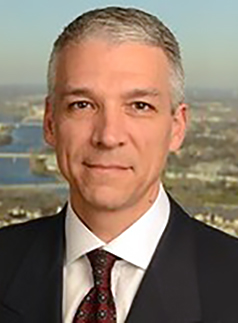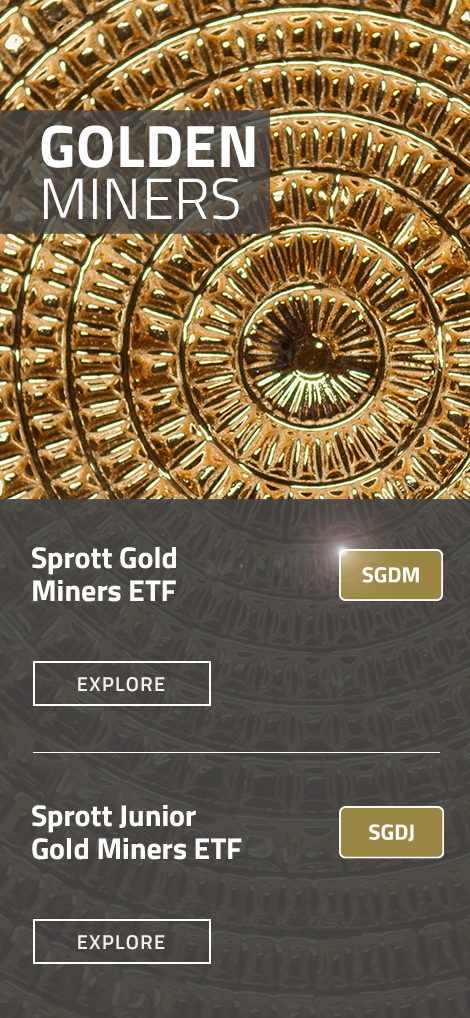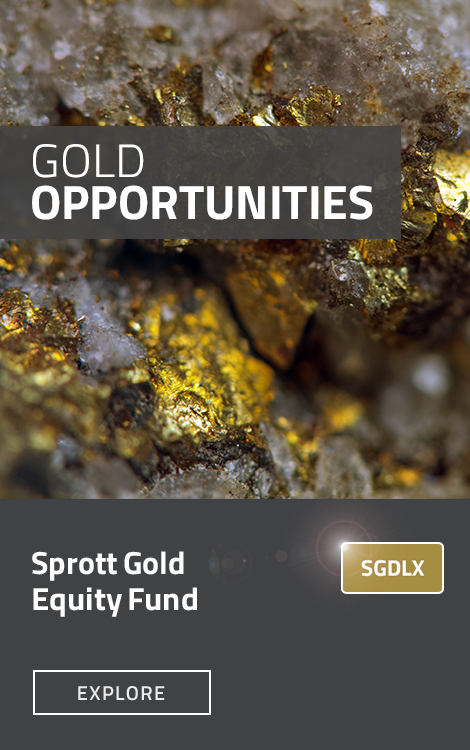Sprott Radio Podcast
Are Gold Miners the New Value Stocks?
Should gold mining stocks be on the radar for value investors? For investors that focus on fundamentals, they are certainly worth a look, even when compared to big tech companies. Jeffrey Huge joins Ed Coyne to make the case.
Podcast Transcript
Ed Coyne: Hello, and welcome to Sprott Radio. I'm your host, Ed Coyne, Senior Managing Partner at Sprott. I'm pleased to welcome a new guest today, Jeffrey Huge, the CIO of JWH Investment Partners, a private family office, and the founder of Alpha Insights, an investment strategy and advisor service for investment professionals. Jeffrey, thank you for joining Sprott Radio today.
Jeffrey Huge: It's great to be here, Ed.
Ed Coyne: I know when we were prepping for today's podcast a bit, you want me to ask particular questions, but I'm going to break the rule right out of the gate here and talk a little bit about yourself. Jeff, could you tell our listeners a little bit about yourself and where you're based? We just met literally last week in Minneapolis, and I know you're based in that area. Talk a little bit about JWH Investment Partners, as well as Alpha Insights, and what that is. Let's start with you first. Please give us a bit about your background and how you got into this business to begin with.
Jeffrey Huge: Absolutely. First, I'm based in Minneapolis, Minnesota. It was nice to meet you at the Titan Investors conference last week. It was a great event. I've been in Minneapolis for my entire career, although I've worked for major Wall Street firms. I started the business in 1990, working at a local firm in town called Piper Jaffray, where I stayed for a couple of years. I was recruited by Merrill Lynch, one of the major Wall Street investment banks, which had a large presence in the Twin Cities, including one of the largest regional offices in the country, run by a man named Dave Patton.
Dave hired me to be an institutional salesman. This was something I did for about 24 years. I was at Merrill until 1999. I left and was recruited to work for, at the time, Salomon Smith Barney, where I essentially did the same thing. I built an office for Salomon Smith Barney in the Twin Cities. Later, the name changed to Citigroup Global Markets, so people would know that as Citigroup today.
I started a family office, JWH Investment Partners, and it's basically house capital. We don't take outside money. I would get so many calls and so many inquiries from former colleagues, former clients asking me, "Hey, Jeff, what are you doing in your own account? What are you trading? What do you like right now?" There were so many that I couldn't field the question.
I began publishing a 10-page chart book. These were my top 10 ideas of the week. Then, I'd send it out to 10, 20, 100, 200, and it had to reach around 4,000 people who were receiving it. It grew from 10 pages to 50 to 100 pages. Now I've consolidated it down into a real business. That was a function of somebody sending me a check one day. I didn't even realize I was in the research business.
One day, somebody said, "Hey, we want to subscribe to Alpha Insights. How much do you charge?" I'm like, "How much do you have in mind?" He's like, "We want to start you with X, and we're going to send you a check." I'm like, "Okay, that'll do." I realized that I was in the research business at that time, and I formalized the product. That was eight years ago when I launched it. We've been publishing a monthly piece called "HUGE INSIGHTS: The Big Picture," which has evolved into a Substack newsletter. That's a very popular Substack right now. We've approximately 6,500 to 6,700 subscribers to that. It can be found on Substack at hugeinsights.substack.com.
Alpha Insights remains our primary institutional product, designed specifically for hedge funds, including long-short hedge funds and global macro hedge funds, that seek big-picture ideas and long-short opportunities within the S&P 1500. We examine the small-cap, mid-cap, and large-cap stock universes. We publish our Alpha Insights weekly playbook every week, where we conduct market analysis across all three areas of market cap. We publish our top five longs and our top five shorts and a few macro ideas within there as well.
We perform a significant amount of sector rotation work and valuation work. This is sent out every Sunday night to several institutional clients that we've been serving for the better part of the last decade. Then, every quarter, we hold a review and outlook meeting. It's a comprehensive, 100-page document that examines various macroeconomic models we've developed, as well as a wide range of equity market indicators and fixed-income market indicators. It also provides a retrospective analysis of the past quarter's performance and projection outlook.
That's basically the product. It's a research product. It's a sidecar to our family office business. There's a group of us that works on it. It's a full-time gig. I alternate between the research business and the family office business.
Ed Coyne: What are some of the key macro drivers right now or things that you're saying are macro drivers that investors should be thinking about or looking out for?
Jeffrey Huge: Ed, the single factor that overlies everything, underscores everything that we're doing in our work today is the U.S. dollar. We believe that the U.S. dollar is on the precipice of another major structural bear market, which could extend for years, if not decades. What we've done is look back at the history of the U.S. dollar, examining it as both a gold-backed currency and a fiat currency. We've noticed this pattern and cycle that exists. That cycle began in 1972 when Nixon took us off the gold standard and began the first structural decline in the U.S. dollar. The U.S. dollar index only goes back to about 1970.
We have a fairly extensive history, spanning approximately 55 years. We can infer what happened prior to that. What we see is that the U.S. dollar index tends to trade down to about 75% of its par value relative to this other basket of currencies. That basket has changed over time with the advent of the euro. We observed the cycle reverse as we approached the 75% level, which occurred around the early 1980s, when it rallied aggressively to a lower high in 1985. That's when the Plaza Accord came out. That was the next catalyst that drove a structural bear market, which lasted from 1985 into the early 2000s.
Then we saw this rally again in the U.S. dollar, reaching a lower high, as Greenspan initiated what I would describe as an era of financial repression. An era during which he collapsed interest rates to 1% and subsequently, they went even lower. This is what really turned the market around, as the dollar peaked again at a lower high and then collapsed back down into the 75% area. That was around roughly 2011-ish. We rallied off that into a new high last December, reaching about 110 on the U.S. dollar index.
From that level, we've come down to a low of around 96%. The 96% level is important because it intersects or coincides with the trend line of the prior lows, including the 2011 low and another 2021 low. Additionally, the 10-year moving average, along with other charts, supports these levels. The breach of the 97-96% level now opens up the potential for the dollar to establish a new structural bear market trend. Our work suggests that over the next 3 to 5 years, and possibly even 10 years, the dollar could come under sustained pressure, potentially declining to around 75%. My suspicion is it's going to happen sooner rather than later.
Ed Coyne: What do you think is driving that? Is it a combination, or is it one or the other of the economic world that is getting bigger? Different parts of the world are starting to have more of a say than they may have had in the past, or are we shrinking? Are we contracting in terms of our relevance to the global economy? What do you think is driving this slow, perpetual slide?
Jeffrey Huge: At a very high level, where it really begins, is that the U.S. debt-to-GDP has ballooned dramatically. It's reached what I believe we can qualify as a tipping point right now. U.S. debt-to-GDP has surpassed 120%, peaking around 125% in recent quarters. In my opinion, at that level, it's just absolutely unsustainable. Another factor contributing to this is the perpetual deficit. We've been running budget deficits of 6% to 7% at the federal level. This is during presumably good economic times, when we're experiencing GDP growth and low unemployment. All systems go.
If you listen to the current administration discuss the condition of the economy, they would have you believe we're in the greatest economy that the world has ever known. If that's the case, why are we running a persistent budget deficit of 6% to 7% and accumulating debt? I'm not the only one asking the question. The rest of the world is asking that question too. They're saying to themselves, "Is the dollar really the safest place for me to go? Is it the place that we really want our reserve assets huddled around?"
Several countries have observed the U.S. using the U.S. dollar as a tool of influence. We've weaponized our currency because of its reserve status. We've used that as a way to put sanctions on other bad actors in the economy. What has happened is that many of these countries have essentially said, "We're going to shift a large portion or a much larger portion of our central bank reserves into an asset that we believe is universally accepted and stable and safe," and that asset has become gold bullion.
Over the last 25 years, what we've seen has been happening slowly and gradually. Things happen gradually and then suddenly, as Hemingway once wrote. The media has only recently become aware of this issue over the last couple of years, but it has been happening for a long time. In fact, foreign central bank reserves have doubled from around 10% on average 25 years ago to about 22% today. Furthermore, they are now higher as a percentage of central bank reserves than U.S. treasuries are, albeit slightly. It's flipped.
We suspect that trend is now structurally ingrained. It hasn't hit a peak and is ready to roll over. It's accelerating, and I think the next step will be for central bank reserves to grow from 20% to 40% over the next 25 years, and that, to me, puts a fundamental floor under the price of gold. Gold will become the default reserve asset for foreign central banks over time.
Ed Coyne: I think people are always surprised when you look at the return patterns of, let's say, gold, for example, over the last two and a half decades. On an annualized basis, even when you include dividends, it's actually outperformed the S&P 500, which is a head-scratcher, because, let's be honest, gold's a rock on a shelf. All these companies in the S&P have earnings, pay dividends, exhibit growth, and possess other key characteristics. Yet this is happening, and I think you're touching on that right now, that there is a shift happening.
The next question would be then, is it an all-or-none for a lot of these parts of the world, where they're like, "We're either going to depend on the U.S. dollar, and we're going to use it as our reserve, or we're not," or are you seeing more of a combination, like, "Yes, we're still going to have some U.S. dollar. We're going to have some gold. We're maybe going to do something else with our own currency"? What's your research telling you? Is it black and white, or is it just a lot of shades of gray right now?
Jeffrey Huge: It's more of a combination, as you alluded to. You must do business with the U.S. market. It's the largest market on the planet. We are the consumers of the goods that the rest of the world produces, and the natural resources that the rest of the world produces. We are the end market. We're the richest country in the world by orders of magnitude. To your earlier point about gold, yes, gold has outperformed the S&P 500 for the last 25 years. In fact, since January 1, 1999, we have examined five main asset classes. We've examined U.S. equities, as defined by the S&P 500, versus gold, versus REITs, versus bonds, versus T-bills, and also versus broader commodities.
Gold has outperformed all of those assets, and not by a small margin, but by a wide margin. In fact, U.S. equities are a distant third in terms of total return over that period of time. One of the significant problems with the U.S. market for corporate stocks and bonds is that it generates its profits in U.S. dollars, and the dollar value is continuing to plummet over time relative to the value of gold. Gold is, as you put it earlier, a rock in the middle of the room. Everything else is just relative to the value of that rock. The rock isn't really going up in value so much as everything else is going down in value.
Ed Coyne: The more I look at it and the more I talk to people like yourselves, what you just said is spot on, that gold's a relative asset. It sits in the middle of the room, and everything else moves around it. The values fluctuate, and gold reflects those changes. Yes, gold's going up, but it doesn't mean you need to run to the hills; it should have your attention on why that is the case.
Additionally, over the last 25-plus years, many people’s biggest objection to gold is that it doesn't do anything. It doesn't have a dividend. It doesn't have earnings. What do you say to an investor when they say, "Why would I invest in gold? It doesn't do anything." What's your standard response to that? How would you get people to rethink that allocation?
Jeffrey Huge: The most important fundamental in any investment scenario is supply and demand. The problem with gold is that it has a very limited supply, and demand is growing at a geometric rate right now. The reason that demand is growing is because of this central bank put that I would describe; if, in fact, this is correct, and I believe it is, that the trend toward gold as a percent of central bank reserve assets is slated to increase and probably double over the next 25 years, then I think there's going to be a steady bid for gold from the investment community who wants to participate in that.
For example, with Bitcoin, there's a limited supply, and supply and demand are going to favor holding that because only a certain amount can be produced at any given point in time. With respect to gold, if you don't really want to invest in the rock itself, you can invest in the companies that are mining gold. Think about this. If you're a fundamental investor, what you're really looking for are highly profitable companies, specifically those with extraordinary gross margins that are sustainable.
If the price of gold is going to steadily increase because of that limited supply and fundamental demand that underscores it, then what you have right now is an industry of the top mining companies that have relatively fixed all-in sustaining costs to mining that every ounce of gold. The current level is around $1,500 to $1,600 for the top 50 North American gold miners. That's your all-in sustaining cost of pulling an ounce of gold out of the ground.
You can sell that ounce of gold today for $4,200 in the futures market. What's the profit margin on that? Nearly 170%. A lot can happen when we're discussing commodity prices, supply and demand, and all the factors that influence them. One thing that isn't going to change is that they won't invent a machine tomorrow that can manufacture more gold out of nothing or mine more gold through an environmentally difficult process at a much higher rate of change than they're currently doing today.
The country that mines the most gold today is China. They are the largest producer, and they consume every ounce that they produce themselves for central bank purposes. I don't see a lot of supply coming on the market.
Ed Coyne: Yes, I always see it's about 1% or 2% a year, given the current outstanding ounces. I want to explore other opportunities. You had mentioned looking at gold relative to other commodities. What other areas are currently capturing your interest?
Jeffrey Huge: Gold's little brother is silver. What happens is that all the trends developing within gold are starting to proliferate throughout the rest of the precious metals complex. As a result, we're seeing the general public accumulate silver in a significant way, and there is a shortage of physical silver to meet that demand. What we're finding is that that is driving the price of silver up at a much faster rate.
For example, year-to-date, the price of silver is up by almost 75%. That's outstripping gold, which is up over 50% year-to-date. Silver, relative to gold, remains very affordable. We examine this long-term ratio, which spans over 50 years, and consider the price of silver in relation to gold, specifically the gold-to-silver ratio. That ratio, when it exceeds, say, 100, tends to indicate that silver is very inexpensive. When it gets down to around 40, that's where silver is a little richer. It's a little more expensive.
Earlier in the year, we saw this relationship peak at about 110, 112, or so, whether you're looking at closing or intraday data. It peaked there, and it's declined dramatically. That ratio is now in the mid-80s. The median ratio is about 64. We're still trading at about a 20% premium to the median, but these swings are very dramatic, both above and below. Reaching the 40 level wouldn't be unusual. That would be the lower boundary of a parallel trend channel that dates back some 50 years.
At the end of the third quarter, we achieved a new quarterly high of over $48. I think that was an important feather in the cap of silver right then and there, because quarterly closing prices are more important than monthly closing, weekly closing, and daily closing. We posted a daily close above $51 the other day. That definitively resolves the pattern with a new all-time closing high.
It's my opinion that we will continue to see this uptrend in the price of silver accelerate from here at a steeper angle of ascent and probably see this relationship between gold and silver move from where it topped around 112 or so, down to a low of around 40, which comes in at the lower boundary of that parallel trend channel.
Ed Coyne: Is there any other topic, theme or idea you'd like to leave the listeners with before we sign off?
Jeffrey Huge: I would just talk about risk management a little bit. Managing your position size is the first line of defense in risk management. Many people come up with a great idea, and it is indeed a great idea. It ultimately works, but they take too big a position size initially, and they've bitten off more than they can chew on, Ed. As a result, when volatility eventually and inevitably enters the market and affects that trade, they lack the wherewithal to withstand it.
Ed Coyne: I think that the concept of managing position size is critical. You hear it all the time. Someone retires from a major corporation, and 70% of their net worth is in this stock. It's the hardest thing for them to do because they've invested their life and soul in a company for four decades or more, sometimes to sell some of that stake because they feel like they're doing the company a disservice.
The reality is you're 100% right on a risk management standpoint. Managing your position sizes and staying committed to them is key. All too often, including myself, when things are working, you really don't want to sell them because it's really fun to see them keep going up. It becomes too overweight, and you have to have that discipline, and conversely, something you love that maybe is not doing as well as you thought. You've got to have that discipline to get it back to that weight in your portfolio.
That's really well said. Managing position size is certainly key. I would agree with that. Jeff, it was great to have you on. I really enjoyed meeting you last week in Minneapolis and hearing your comments on that panel. Thanks again for taking the time today.
Jeffrey Huge: Absolutely. Thank you so much for having me on the podcast today. It was a pleasure meeting you as well.
Ed Coyne: My pleasure. Once again, my name is Ed Coyne. Thank you all for listening to Sprott Radio.
Important Disclosure
This podcast is provided for information purposes only from sources believed to be reliable. However, Sprott does not warrant its completeness or accuracy. Any opinions and estimates constitute our judgment as of the date of this material and are subject to change without notice. Past performance is not indicative of future results. This communication is not intended as an offer or solicitation for the purchase or sale of any financial instrument.
Relative to other sectors, precious metals and natural resources investments have higher headline risk and are more sensitive to changes in economic data, political or regulatory events, and underlying commodity price fluctuations. Risks related to extraction, storage and liquidity should also be considered.
Gold and precious metals are referred to with terms of art like store of value, safe haven and safe asset. These terms should not be construed to guarantee any form of investment safety. While “safe” assets like gold, Treasuries, money market funds and cash generally do not carry a high risk of loss relative to other asset classes, any asset may lose value, which may involve the complete loss of invested principal. Furthermore, no asset class provides investment and/or wealth “protection”.
Any opinions and recommendations herein do not take into account individual client circumstances, objectives, or needs and are not intended as recommendations of particular securities, financial instruments, or strategies. You must make your own independent decisions regarding any securities, financial instruments or strategies mentioned or related to the information herein.
While Sprott believes the use of any forward-looking language (e.g, expect, anticipate, continue, estimate, may, will, project, should, believe, plans, intends, and similar expressions) to be reasonable in the context above, the language should not be construed to guarantee future results, performance, or investment outcomes.
This communication may not be redistributed or retransmitted, in whole or in part, or in any form or manner, without the express written consent of Sprott. Any unauthorized use or disclosure is prohibited. Receipt and review of this information constitute your agreement not to redistribute or retransmit the contents and information contained in this communication without first obtaining express permission from an authorized officer of Sprott.
©Copyright 2025 Sprott All rights reserved







